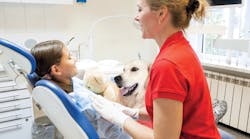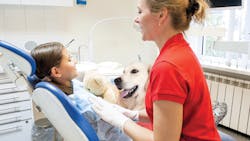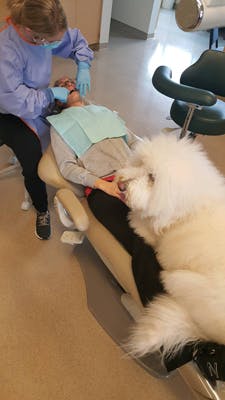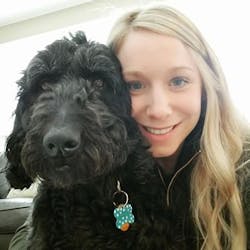By Alexis Ohrstrom, BS, Natalie Baz, BS, and Gail Aamodt, MS, RD
Pets have long played an important role in the American family. The human-animal bond is also well established in the medical field,1 but this concept is lagging behind in the dental field. This article describes the benefits of animal-assisted therapy (AAT), along with the risks and barriers of incorporating AAT into the dental office.
Research has shown that dogs can improve overall health by lowering blood pressure, providing comfort, and improving mood.1 Many of those who oppose AAT are concerned with infection control and the possibility of zoonotic diseases (infectious diseases that can be transmitted from animals to humans under normal circumstances). A survey was conducted to identify the opinions of dentists and dental hygienists regarding the use of AAT in the dental office.2
Under the Americans with Disabilities Act, state and local governments, businesses, and nonprofit organizations that serve the public generally must allow service animals to accompany people with disabilities in all areas of a facility where the public is allowed. For example, in a hospital, a service animal would be allowed in patient rooms, clinics, cafeterias, and exam rooms. However, it may be appropriate to exclude a service animal from operating rooms or burn units where the animal’s presence may compromise a sterile environment.
Based on frequency of postings on social media, health-care facilities have recently shown an increased interest in therapy animals and facility dogs. In addition to lowering blood pressure and improving mood, animal-assisted intervention programs have also been shown to delay the onset of dementia.1 AAT is currently being used in elder-care facilities, hospitals, and mental health therapy sessions, but is less common in the dental field. If employed, AAT may be able to reduce anxiety and improve the dental experience.
There is mixed research on the medical evidence of using AAT. Results of one study showed that patients with mood disorders, psychotic disorders, or other mental health disorders had decreased anxiety scores using AAT in a single regular session when compared to a regular therapy session.3 Another study conducted in a pediatric dental office showed children who verbalized being stressed when going to the dentist had less physiologic behavior distress after the use of a companion dog.4
While much of the research supports the value of animals for therapeutic use, some research has found no significant difference and even some adverse events associated with AAT. These may include phobias, allergies, and zoonotic disease transmission, which makes infection control a major concern.5 In a recent study, the health and safety policy varied widely and potentially compromised human and animal safety.
The Society for Healthcare Epidemiology of America (SHEA) has identified guidelines for an animal in health-care facilities that include important steps, policies, AAT visit liaisons, and training programs for animals and handlers. When followed, these guidelines can lessen the risks associated with AAT.6 Other considerations when using AAT should include restrictions on age, origin, behavior, and health status of the animal.6 With well-defined and followed guidelines, dogs can perform useful functions in medical settings.1
Benefits of AAT
AAT can have many benefits for patients. It is a less invasive way to reduce anxiety and stress in the dental setting than the administration of anti-anxiety medication to lower blood pressure, provide comfort, and improve mood. These positive health benefits may affect many populations, ranging from the elderly to children with different cognitive abilities. Blood pressure can be lowered when a patient pets a dog, which can be good for those who have dental anxiety. Incorporating AAT also moves the focus onto the dog instead of a patient’s symptoms or pain.1
Risks of AAT
Animal-assisted therapy may be beneficial in reducing dental anxiety, however, there are many risks involved. These include allergies to pet dander, zoonotic diseases, fear of animals, and infection control concerns. According to the Centers for Disease Control and Prevention, there are more than 200 zoonotic diseases. Those who are at high risk of contracting these diseases include the elderly, pregnant women, young children, and immunocompromised individuals.
Currently, no human or animal health regulatory agencies are responsible for monitoring or regulating animal-assisted programs.5 However, guidelines have been set by SHEA, and it is recommended that these guidelines be followed when using AAT. According to a study conducted in an elder-care facility, many facilities are unaware of and inconsistent with following the proper guidelines.6
Criteria and recommendations
For a successful AAT program, we recommend following the standards for animal-assisted therapy training, which can be found at petpartners.org. Pet Partners’ standards are endorsed by SHEA. Pet Partners provides a 90-minute online course for pet handlers and health-care providers that can lead to certification. Guidelines for using AAT have been set by the American Veterinary Medical Association and can be found at avma.org/KB/Policies/Pages/Animal-Assisted-Interventions-Guidelines.aspx.
• At least one person must be responsible for the health, behavior, and welfare of the animal(s)
involved in these programs.
• A close partnership and frequent communication must be maintained between the veterinarian, responsible person, licensed therapists responsible for the human participant (e.g., occupational and physical therapists), and, where necessary, a qualified animal behaviorist.
• AAT dogs must have vaccinations; parasite prevention and control; selected screening for common diseases and conditions; behavioral evaluation; preventive medical, dental, nutritional, and behavioral care, including advice concerning environmental enrichment; and an assessment of genetic health as appropriate.
• Animals need to be bathed within 24 hours of a visit.
• Animals should participate only at appropriate ages, taking into account physical and zoonotic risks, behavioral appropriateness, and stressors that may adversely affect young or elderly animals in these programs.
• Facilities should develop a written policy for animal-assisted activities. An animal-assisted activity visit liaison should be designated.
• Animals and handlers should be formally trained and evaluated.
• Animal interaction areas should be determined in collaboration with the infection prevention and control team. In addition, all clinical staff should be educated about the program.
• Animal handlers must have all required immunizations, restrict contact of their animal to patients visited, prevent the animal from having contact with invasive devices, and require that everyone who touches the animal practice hand hygiene before and after contact.
Dental treatment can be more relaxing for animal-loving patients who are afraid of the dentist.
Survey results
A survey was developed to assess the opinions of Washington County Dental Association component members, Pacific University graduates, and Pacific University faculty about the use of AAT in the dental office. The survey was approved by the Pacific University Institutional Review Board and distributed via email using the online program Qualtrics.
There were 51 responses of which 94% were licensed dental hygienists. Of the responses, 56% reported being unaware of the difference between a service animal and AAT. Nearly half of the respondents (49%) claimed that they would consider using AAT in their offices; however, 27% were undecided about incorporating AAT into their offices, and 23% were not interested. Only 3% thought that their dental office would lose patients if they offered AAT. Infection control and patient allergies were the two major concerns of using AAT in the dental office.
Discussion
The use of AAT is evolving in the medical field and has demonstrated positive outcomes.3 Institutions and universities have adopted AAT into their facilities. Oregon Health and Science University (OHSU) and the Children’s Hospital & Medical Center in Nebraska have both incorporated dogs into their facilities. According to the OHSU website, anyone wanting an animal to participate in their therapy animal program must have a complex rating from Pet Partners, DoveLewis Emergency Pet Hospital, or an equivalent organization. Animals are required to have certification renewed every year to ensure that the pet is trained and can handle the hospital atmosphere.
In some environments, such as hospitals, the use of AAT is a complementary service. Using AAT could be a deciding factor, positive or negative, for families when choosing hospitals, counselors, physical therapy centers, etc. With the positive benefits of AAT, it can make life a little more bearable during high-stress situations such as dental work. However, concerns regarding infection control and allergies inside health-care facilities are valid. Questions that need to be addressed include: Do the positive effects outweigh the concerns that are associated with the use of AAT in the dental office? With animal-assisted therapy growing, is it time for dentistry to adopt it?
Future steps
While we believe the benefits outweigh the risks of AAT, education is needed to safely employ it in medical and dental offices to ensure the health of both patients and animals. Education should include the recommendations, guidelines, and training protocols provided by the CDC, SHEA, and Pet Partners to anyone considering adding AAT into their office.
Educating dental health-care providers on the uses, benefits, risks, and research of AAT in the dental field could help increase its support in the field. Providing valid research that supports the use of AAT could help gain approval from dental and dental hygiene schools, which in turn could help implement AAT in the dental field.
Conclusion
Overall, there is a lack of research regarding the use of AAT in the dental office. Further research is needed on the use, benefits, risks, and barriers of AAT to be able to determine whether it is actually beneficial and recommended in the dental field. Gaps in the literature include a lack of studies completed in dental settings and a relatively small sample size in the research articles that have been published. The stress of the animals involved in therapy should also be researched and considered. Insurance coverage and costs associated with AAT also need further
investigation.
References
1. Matuszek S. Animal-facilitated therapy in various patient populations. Holistic Nursing Practice.https://pdfs.semanticscholar.org/1d60/f271eb61bace83465b5b5d138983b11e7f79.pdf. Published July/August 2010. Accessed June 26, 2018.
2. Gussgard AM. Dog-assisted therapy in dentistry. ClinicalTrials.gov. https://clinicaltrials.gov/ct2/show/NCT03324347. Published October 31, 2017. Accessed July 23, 2018.
3. Barker S, Dawson K. The effects of animal-assisted therapy on anxiety ratings of hospitalized psychiatric patients. Psychiatry Online website. https://ps.psychiatryonline.org/doi/abs/10.1176/ps.49.6.797. Published June 1, 1998. Accessed June 26, 2018.
4. Havener L, Gentes L, Thaler B, et al. The effects of a companion animal on distress in children undergoing dental procedures. Issues Compr Pediatric Nurs. 2001;24(2):137-152.
5. DiSalvo H, Haiduven D, Johnson N, et al. Who let the dogs out? Infection control did: Utility of dogs in health care settings and infection control aspects. Am J Infect Control. 2006;34(5):30-307.
6. Linder DE, Siebens HC, Mueller MK, Gibbs DM, Freeman LM. Animal-assisted interventions: A national survey of health and safety policies in hospitals, eldercare facilities, and therapy animal organizations. Am J Infect Control. 2017;45(8):883–887.
Gail Aamodt, RDH, MS, has more than 40 years of clinical experience and 18 years of teaching experience in dental hygiene education. Her areas of expertise and interest include interprofessional education, learner-centered education, team development, pain management, and dental therapy.
Definitions
Animal-assisted therapy (AAT) is a therapeutic intervention that incorporates animals to enhance and complement the benefits of traditional therapy. The goal of AAT is to improve a patient’s social, emotional, or cognitive functioning. Animals can provide a sense of calm, comfort, or safety and divert attention away from a stressful situation and toward one that provides pleasure. Air Carrier Access Act (ACAA) and CFR Part 382; AVMA Animal-Assisted Interventions: Definitions
Service animal: According to the Americans with Disabilities Act (ADA), a service animal is “any dog that is individually trained to do work or perform tasks for the benefit of an individual with a disability, including a physical, sensory, psychiatric, intellectual, or other mental disability. Other species of animals, whether wild or domestic, trained or untrained, are not considered service animals.” Service animals are working animals, not pets. The work a dog has been trained to provide must be directly related to the person’s disability. Dogs whose sole function is to provide comfort or emotional support do not qualify as service animals under the ADA. Americans with Disabilities Act 1990 (Section 35.136)










